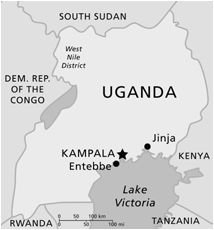 In 1979, Uganda’s ruthless despot was now on the run and the country was in severe turmoil. The Ugandan people had already experienced so much pain and hardship during the last five years of Idi Amin’s rule. Up to 500,000 people had been killed by his regime; many more were tormented and tortured. Now things were getting worse. Fighting had broken out between tribal and political factions, food was scarce, and supplies were almost exhausted. My wife and I discussed the unfolding crisis in East Africa. We decided that I should use the sixty days of military leave I had accrued to go to Uganda to assist in any way I could.
In 1979, Uganda’s ruthless despot was now on the run and the country was in severe turmoil. The Ugandan people had already experienced so much pain and hardship during the last five years of Idi Amin’s rule. Up to 500,000 people had been killed by his regime; many more were tormented and tortured. Now things were getting worse. Fighting had broken out between tribal and political factions, food was scarce, and supplies were almost exhausted. My wife and I discussed the unfolding crisis in East Africa. We decided that I should use the sixty days of military leave I had accrued to go to Uganda to assist in any way I could.
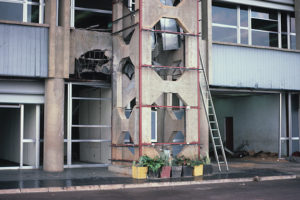 Arriving at Entebbe Airport, about 25 miles from Kampala, I saw many green military tents and large anti-aircraft guns just a few hundred feet away from the runway. Parking at the terminal, I saw that most of the terminal windows were broken and the airport facilities were in utter disrepair. After learning that all my tools were missing, I made my way to Mengo Hospital in Kampala—my home for the next two months.
Arriving at Entebbe Airport, about 25 miles from Kampala, I saw many green military tents and large anti-aircraft guns just a few hundred feet away from the runway. Parking at the terminal, I saw that most of the terminal windows were broken and the airport facilities were in utter disrepair. After learning that all my tools were missing, I made my way to Mengo Hospital in Kampala—my home for the next two months.
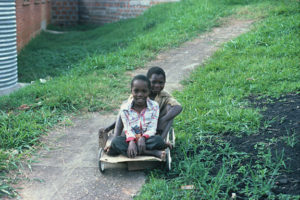 The next morning, I passed two cute little children as I walked up the hill for my first day at work. These youngsters had probably never tasted flour, sugar, salt, and possibly even milk because grocery stores had been looted or destroyed. Water was also very scarce. The hospital did not have a water source, so it traded medical services and surgeries for containers of water instead of accepting the inflated and nearly worthless Ugandan currency from its patients.
The next morning, I passed two cute little children as I walked up the hill for my first day at work. These youngsters had probably never tasted flour, sugar, salt, and possibly even milk because grocery stores had been looted or destroyed. Water was also very scarce. The hospital did not have a water source, so it traded medical services and surgeries for containers of water instead of accepting the inflated and nearly worthless Ugandan currency from its patients.
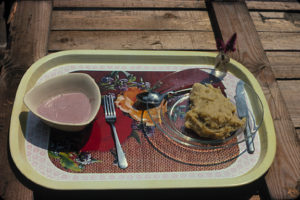 Despite these shortages, the hospital staff shared their food with me. We ate mashed matoke bananas with occasional groundnut sauce for every meal, delivered on a metal tray with half a glass of water and a pretty leaf or flower placed in an empty penicillin vial that served as a little makeshift vase. That daily flower made me smile with gratitude for the kindness of the hospital staff and life’s little blessings that I had often taken for granted before coming to Uganda.
Despite these shortages, the hospital staff shared their food with me. We ate mashed matoke bananas with occasional groundnut sauce for every meal, delivered on a metal tray with half a glass of water and a pretty leaf or flower placed in an empty penicillin vial that served as a little makeshift vase. That daily flower made me smile with gratitude for the kindness of the hospital staff and life’s little blessings that I had often taken for granted before coming to Uganda.
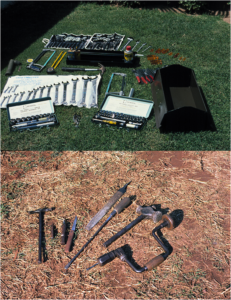 Since my bag of tools had suspiciously disappeared in the flight from Nairobi, I had to make some. I fashioned a hammer from part of a bicycle pedal and a very large bolt; screwdrivers out of large nails; and an electrical continuity tester out of a light bulb and some wire. A hotplate and a nail became my soldering iron, and I harvested solder from inoperative circuit boards. The gummy sap we collected from black wattle trees became insulating material and also served as makeshift glue.
Since my bag of tools had suspiciously disappeared in the flight from Nairobi, I had to make some. I fashioned a hammer from part of a bicycle pedal and a very large bolt; screwdrivers out of large nails; and an electrical continuity tester out of a light bulb and some wire. A hotplate and a nail became my soldering iron, and I harvested solder from inoperative circuit boards. The gummy sap we collected from black wattle trees became insulating material and also served as makeshift glue.
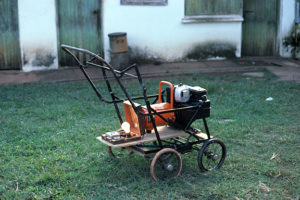 While exploring a storeroom, I found a small electric generator. After repairing the motor, we mounted the now-working generator onto an old wheelchair chassis and then rewired the maternity ward and operating theater lights to work with this portable generator.
While exploring a storeroom, I found a small electric generator. After repairing the motor, we mounted the now-working generator onto an old wheelchair chassis and then rewired the maternity ward and operating theater lights to work with this portable generator.
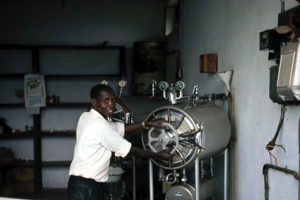 Dr. Musaba and the nurses also needed a way to sterilize the bottles used for intravenous (IV) fluid. We were able to repair the hospital’s autoclave, fill it daily using a bucket and a small funnel, and sterilize IV-fluid bottles and surgical instruments every day.
Dr. Musaba and the nurses also needed a way to sterilize the bottles used for intravenous (IV) fluid. We were able to repair the hospital’s autoclave, fill it daily using a bucket and a small funnel, and sterilize IV-fluid bottles and surgical instruments every day.
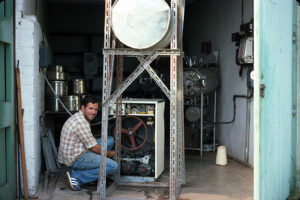 Washing hospital clothing and sheets by hand was difficult and wasted lots of water. We found an old washing machine, but a rat had built its home in the electronic control compartment, eating away much of the plastic insulation from the wires. Using tree sap and other makeshift substitutes, we coerced that old machine to work again. Then George and I built a water recycling system, using a small tower and three 55-gallon drums, to reuse and conserve our precious water supply.
Washing hospital clothing and sheets by hand was difficult and wasted lots of water. We found an old washing machine, but a rat had built its home in the electronic control compartment, eating away much of the plastic insulation from the wires. Using tree sap and other makeshift substitutes, we coerced that old machine to work again. Then George and I built a water recycling system, using a small tower and three 55-gallon drums, to reuse and conserve our precious water supply.
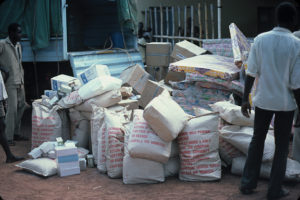 When searching through cargo buildings for my tools, I came across a warehouse filled with medical supplies and mattresses donated by non-governmental organizations in Europe. I rented a large truck from the Catholic Church in Kampala, stealthily loaded it up, and took off early the next morning with two helpers toward eastern Uganda to distribute this aid to hospitals and clinics.
When searching through cargo buildings for my tools, I came across a warehouse filled with medical supplies and mattresses donated by non-governmental organizations in Europe. I rented a large truck from the Catholic Church in Kampala, stealthily loaded it up, and took off early the next morning with two helpers toward eastern Uganda to distribute this aid to hospitals and clinics.
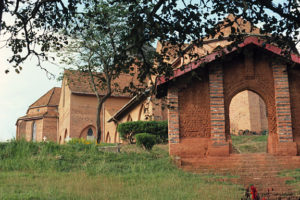 On Sunday mornings, I would make my way up to the castle-like Saint Paul’s Cathedral at the top of Namirembe Hill. Sitting in the wooden pew before the service, my engineering mind thought about the challenges of constructing this beautiful sanctuary in 1915. The massive columns and buttresses stand as true works of art; the stones had been hand-hewn in local quarries and transported up the hill. The enormous wooden arches and high vaulted ceiling had to be put up using a complex network of wooden or bamboo scaffolds.
On Sunday mornings, I would make my way up to the castle-like Saint Paul’s Cathedral at the top of Namirembe Hill. Sitting in the wooden pew before the service, my engineering mind thought about the challenges of constructing this beautiful sanctuary in 1915. The massive columns and buttresses stand as true works of art; the stones had been hand-hewn in local quarries and transported up the hill. The enormous wooden arches and high vaulted ceiling had to be put up using a complex network of wooden or bamboo scaffolds. 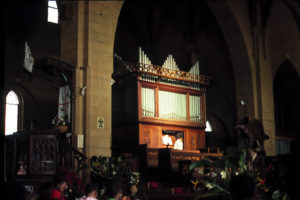 When dedicated over a century ago, this magnificent cathedral was both a grand tribute to dedicated architects, engineers, and laborers who constructed it and a quiet haven to help future generations worship our Maker, Provider, and Comforter.
When dedicated over a century ago, this magnificent cathedral was both a grand tribute to dedicated architects, engineers, and laborers who constructed it and a quiet haven to help future generations worship our Maker, Provider, and Comforter.
Services followed a central theme—God’s ways are perfect, forget the horrors of the past, and make a new future. The bishops and pastors would talk about forgiveness, looking at the brighter side, and being thankful for today’s blessings. They spoke about valuing life itself as a special gift from God to be nurtured and cherished.
The Ugandan people taught me a great deal about priorities and the important things in life. My trip to Kampala was a life-changing experience. I left people behind who subsisted on matoke bananas and maybe half a glass of water a day. I left people behind who lived with gunshots shattering the quietness of night, followed by the sound of ricocheting bullets, barking dogs, and wailing people.
Prices of food and clothes were exo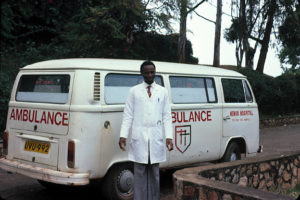 rbitant. My new friends survived on so little, yet shared what they had. Their positive attitude in the face of nearly impossible struggles made me ashamed of my sometimes ungrateful attitude.
rbitant. My new friends survived on so little, yet shared what they had. Their positive attitude in the face of nearly impossible struggles made me ashamed of my sometimes ungrateful attitude.
I realized anew that we have so much for which to be thankful and so many blessings to share. The optimistic outlook of my Ugandan friends challenged me to have a positive attitude regardless of my surroundings, to cherish life and nurture relationships, and to share my blessings with others, even if those were just a green leaf or a colorful flower in a used penicillin vial.